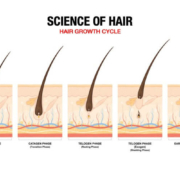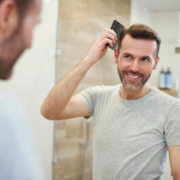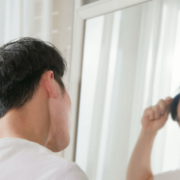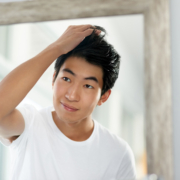How to Make Hair Grow Faster: 2 Essential Facts You Should Know
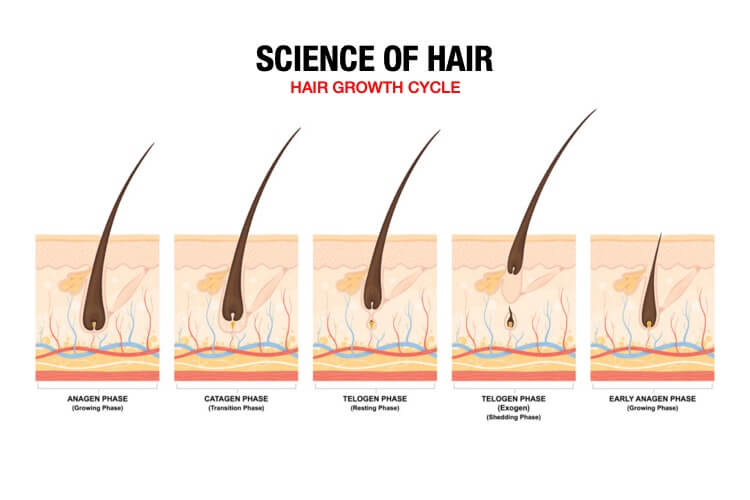
How fast does your hair grow? If you’re anxious about your hair, your answer might be, “Not fast enough!” Although you can’t grow long hair overnight, there are some steps you can take to make your hair grow faster. Knowing the basic facts about hair growth can help you make better choices regarding your hair.
Fact No. 1: Growth Starts at the Scalp
When it comes to the health of their hair, most people concentrate on the hair itself and overlook the skin on their scalp. The scalp is more than something your hair adheres to, however. It’s like soil for your hair. Just like you can’t grow plants in poor soil, you can’t grow healthy hair on an unhealthy scalp!
According to the American Academy of Dermatology Association, humans have an average of 100,000 hair follicles with each follicle containing one strand of hair. Blood flow throughout the scalp feeds hair follicles, and without proper blood flow, the appropriate balance of microorganisms, and stable oil production the hair follicles fail to produce healthy hair. Hair grows from the root, not from the tips. The follicle contains a hair bulb that actively grows the strand of hair. (01, 02)
A scalp without healthy blood flow or nutrients is like infertile soil, and can result in weak hair or a loss of hair. Furthermore, each follicle produces sebum to moisturize and strengthen the scalp, creating the right pH balance to keep harmful microorganisms in check. So, follicles need a good balance of sebum and the right nutrients to do their job. Alopecia areata, for example, is an immune disorder that targets hair follicles, compromising their ability to function and causing patchy hair loss as a result. (03, 04)
What You Can Do:
To keep your hair growing as quickly as possible, take care of your scalp. And to keep your scalp in good condition the following is recommended:
- Avoid hair products with drying agents like alcohol, sulfates, alcohols, or fragrances as these can strip away natural oils and irritate the scalp.
- Practice sun protection for your scalp by using a water-resistant, broad spectrum sunscreen with an SPF of 30 or higher on any visible portions of your skin and scalp.
- Stay clear of harsh chemicals like dye and bleach, as these can cause scalp injuries.
- Gently massage the scalp while shampooing to increase circulation.
- Eat a nutritious diet. Nourishing your scalp by consuming foods rich in hair-friendly vitamins and minerals may help boost hair growth. The following are examples of foods that encourage hair growth:
- High-quality protein-rich foods
- Food high in biotin like eggs, almonds, and avocado.
- Fresh fruits and vegetables high in vitamin C, zinc, and B vitamins.
- Cysteine contains foods like garlic, poultry, brussel sprouts, and yogurt.
Fact No. 2: Hair Has a Growth Cycle
Skin cells form through continuous division, with new cells eventually pushing old cells up and out. Similar to skin cells, hair grows through division on a cyclical growth pattern. Individual strands of hair go through a rapid phase of growth and slower phases, then eventually fall out. Each hair will not stay on your head forever and will naturally fall away from the hair follicle at some point, where another hair will typically grow in its place. These are the three primary growth phases of your hair.
Anagen Phase
During the anagen phase, also known as the “Growth Phase,” the hair emerges from the follicle. Consisting of proteins and keratin, hair grows and sebaceous glands condition the hair during this time. Hair grows at an average rate of about 6 inches every year. About 80% of hair is in the anagen phase, which can last about 2 to 8 years. (02) Conditions like androgenic alopecia occur during the anagen phase, shortening the growth cycle of hair and impairing healthy hair growth. (05)
Catagen Phase
In contrast to the anagen phase, the catagen phase is a brief period that lasts only about 10 days, although sometimes can remain up to 4 to 6 weeks. During the catagen phase, which accounts for 1 to 2 percent of hair, growth stops and the hair follicle shrinks. The part of the follicle that nourishes the hair shuts down to rest. (02)
It’s during the catagen phase that club hair forms. Club hairs are the final state of an attached hair and is a natural part of a hair’s growth cycle. A keratin ball forms at the end of a strand of hair (club hair), keeping it in place until the strand is shed and a new growth cycle begins. If enough club hairs fall out at the same time, hair may appear less full.
Health conditions like hypothyroidism, hormonal changes, and nutritional deficiencies can cause more club hairs to form than usual, which then fall out around the same time and creates thinner hair. During this phase and the next –the telogen phase – hairs are vulnerable to tugging and pulling and may easily fall out, like in a condition called traction alopecia. (02)
Telogen Phase
The telogen phase is the resting phase, when hair falls out of the follicle. Lasting about 2 to 3 months, the dermal papilla rests during the telogen phase. As the dermal papilla rests, no nutrients are supplied to the hair — causing the hair to fall out and preventing further growth. The tail end of the telogen phase is called the “exogen phase,” where hair falls out of the follicle. Roughly 15 percent of hair is in the telogen phase at any given time, with the scalp shedding an average of 100 hairs a day. (02)
If a disruption occurs in hair growth at any point in the cycle, the change can affect more hairs than is usual — placing more hairs into the catagen or telogen phase at the same time. Therefore, more than the typical amount of hair sheds all at once. Telogen effluvium is one such example of a hair loss condition that occurs because of stressors like illness or trauma during the telogen phase.
What to Do:
- Accept some loss of hair. Knowing that shedding roughly 100 hairs a day is part of the normal growth cycle can keep you from worrying unnecessarily about hair loss.
- Because hair grows from the root, trimming your hair will not speed up hair growth. However, trimming your hair every 2 months can keep your hair strong by preventing split ends and breakage.
- Avoid tight fitting headgear if at all possible.
- Be aware of how you handle your hair, especially when you’re anxious. Anxiety-related conditions like trichotillomania (an irresistible urge to pull or tug at hair) can result in bald patchy areas and disrupt the growth stages of hair. Prevent yourself from picking or rubbing at your scalp and hair.
- A cold or lukewarm shower keeps hair follicles tight and therefore more likely to hold on to hair, especially during the telogen phase. Hot water, on the other hand, can encourage follicles to shed their hair and should be avoided.
Know When to Get Assistance
There’s no magic wand that will suddenly grow hair, but following the recommendations above and establishing healthy hair care habits can help you keep as much of the hair that you have. If you’re doing all you can to care for your scalp and you’re still experiencing slow hair growth, consult with your physician. The solution might just be a prescription away!
Resources:
(01) https://www.aad.org/public/parents-kids/healthy-habits/parents/kids/hair-grows
(02) https://www.ncbi.nlm.nih.gov/books/NBK499948/
(03) https://www.ncbi.nlm.nih.gov/pmc/articles/PMC6369642/
(04) https://www.aad.org/public/diseases/hair-loss/types/alopecia(05) https://medlineplus.gov/genetics/condition/androgenetic-alopecia/#causes

